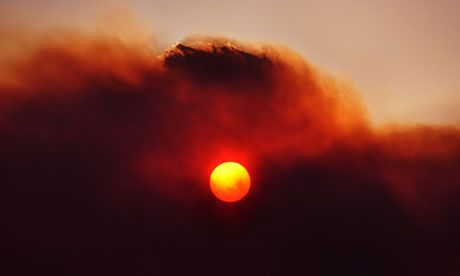Podcast: Play in new window | Download
Subscribe: RSS
 This is a shape of things to come: intolerable heat persisting for unprecedented lengths of time; failure of the electric grid when it’s needed most; hundreds of deaths from the searing heat; unreasoning violence spreading across the county like fire. India had it all last week, and the relief brought by the (late) onset of monsoon rains may be scant and temporary. This is the specter of climate change made real, made explicit, in the present tense. And still the world acts as if it’s the other guy’s end of the boat that’s burning, no worries here.
This is a shape of things to come: intolerable heat persisting for unprecedented lengths of time; failure of the electric grid when it’s needed most; hundreds of deaths from the searing heat; unreasoning violence spreading across the county like fire. India had it all last week, and the relief brought by the (late) onset of monsoon rains may be scant and temporary. This is the specter of climate change made real, made explicit, in the present tense. And still the world acts as if it’s the other guy’s end of the boat that’s burning, no worries here.
In Delhi last week the temperature reached at least 113 degrees Fahrenheit for six days in succession. On June 11th the high there was 118. The heat caused demand for electricity that exceeded 11,000 megawatts on a system whose top capacity is 8,000 megawatts. Rolling blackouts, imposed to try to save the grid, along with blackouts caused by equipment failures, shut down air conditioners, fans and water pumps just when they were most needed. In cities such as Delhi, the heat turned the air toxic. Levels of ground-level ozone, a product of the sun’s heat acting on auto emissions, more than doubled.
Desperate people began to sleep outside, even on cots in city streets, to escape their stifling homes. But as the heat wave became the longest on record, with temperatures rising faster during the day and staying higher through the night, desperation turned to anger (with a little help from the opposition party that just lost an election to a new prime minister who promised to provide reliable electricity. He’s been in office for three weeks). Rioters began to clash with police, burn power substations, trash electric-utility-company offices and take power workers hostage.
It was hard to follow the rioters’ logic, but impossible to mistake their desperation.
Relief began to arrive this week in the form of a late and probably weak monsoon — rains that are moving across the entire country and should persist until September. Meteorologists are worried that in this El Nino year, the rains may be well below normal, and say there is a one in three chance of drought. In addition to affecting the food supply, that would be another blow to the country’s power supply, nearly half of which is hydropower.
Meanwhile India has been accelerating its coal imports to try to keep up with demand, which has been increased as a result of burning coal.
India is showing us what is going to happen. Is anybody taking notes?
See also: